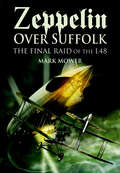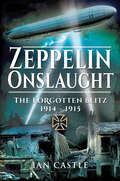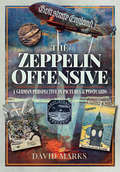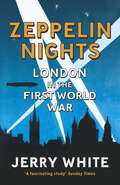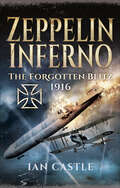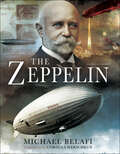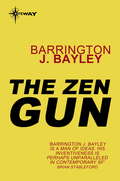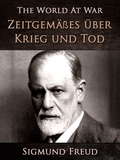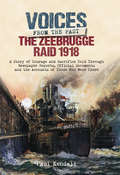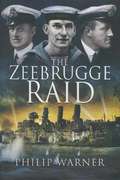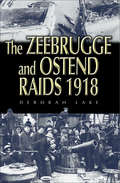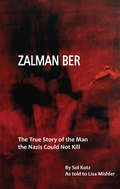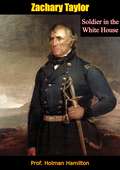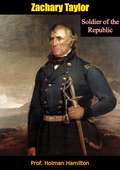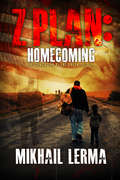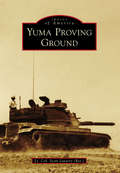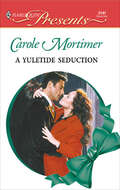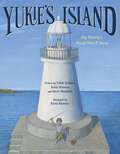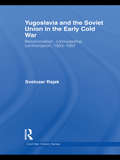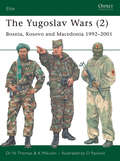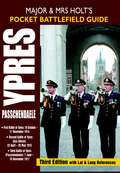- Table View
- List View
Zeppelin over Suffolk: The Final Raid of the L48
by Mark MowerThe dramatic story of the final mission and moments of the German Navy&’s prized airship during World War I. Zeppelin Over Suffolk tells the remarkable story of the destruction of a German airship over East Anglia in 1917. The drama is set against the backdrop of Germany&’s aerial bombing campaign on Britain in the First World War, using a terrifying new weapon, the Zeppelin. The course of the raid on that summer night is reconstructed in vivid detail, moment by moment—the Zeppelin&’s take off from northern Germany, its slow journey across the North Sea, the bombing run along the East Anglian coast, the pursuit by British fighters high over Suffolk, and the airship&’s final moments as it fell to earth in flames near the village of Theberton in the early morning of 17 June 1917. Mark Mower gives a gripping account of a pivotal episode in the pioneering days of the air war over England.
Zeppelin Onslaught: The Forgotten Blitz, 1914–1915
by Ian CastleAt the outbreak of the First World War, the United Kingdom had no aerial defense capability worthy of the name. Britain had just thirty guns to defend the entire country, with all but five of these considered of dubious value. So when raiding German aircraft finally appeared over Britain the response was negligible and ineffective. Of Britains fledgling air forces, the Royal Flying Corps had accompanied the British Expeditionary Force into Europe leaving the Royal Naval Air Service to defend the country as best it could. That task was not an easy one.From the first raid in December 1914, aerial attacks gradually increased through 1915, culminating in highly damaging assaults on London in September and October. London, however, was not the only recipient of German bombs, with counties from Northumberland to Kent also experiencing the indiscriminate death and destruction found in this new theater of war the Home Front. And when the previously unimagined horror of bombs falling from the sky began, the British population was initially left exposed and largely undefended as civilians were killed in the streets or lying asleep in their beds. The face of war had changed forever and those raids on London in the autumn of 1915 finally forced the government to pursue a more effective defense against air attack.This German air campaign against the United Kingdom was the first sustained strategic aerial bombing campaign in history. Yet it has become the forgotten Blitz.In Zeppelin Onslaught Ian Castle tells the complete story of the 1915 raids in unprecedented detail in what is the first in a planned series of three books that will eventually provide a complete history of Britains Forgotten Blitz of 1914–18.
The Zeppelin Offensive: A German Perspective in Pictures and Postcards
by David MarksAirship propaganda that&’s &“a visual treat . . . it will appeal to all those interested in how artwork was harnessed to convey information in time of war&” (Firetrench). Books on the Zeppelin raids during the First World War have, traditionally, focused on the direct impact of Britain, from the devastating effects on undefended towns and cities, the psychological impact of this first weapon of total war to the technological and strategic advances that eventually defeated the &“Baby Killers.&” Now, drawing on the largest postcard collection of its kind and other period memorabilia, David Marks tells the story of the Zeppelin during the First World War from a viewpoint that has rarely been considered: Germany itself. From its maiden flight in July 1900, the Zeppelin evolved into a symbol of technology and national pride that, once war was declared, was at the forefront of German&’s propaganda campaign. The Zeppelin links the rampant xenophobia at the outbreak of the conflict against England (it almost never was called Britain), France, Russia and their allies to the political doctrines of the day. The postcards that profusely illustrate this book show the wide-ranging types of propaganda from strident Teutonic imagery, myths and legends, biting satire and a surprising amount of humor. This book is a unique contribution to our understanding of the place of the Zeppelin in Germany&’s culture and society during the First World War. &“Well-recommended for its unique visual and psychological insights.&” —Over the Front &“Perfectly conveys the early optimism of the Zeppelin as both a symbol of national prestige and the weapon which would win the War.&” —Donna&’s Book Blog
Zeppelin Nights: London in the First World War
by Jerry White‘Zeppelin Nights is social history at its best… White creates a vivid picture of a city changed forever by war’ The Times2018 marks the centenary of the end of the First World War. In those four decisive years, London was irrevocably changed. Soldiers passed through the capital on their way to the front and wounded men were brought back to be treated in London’s hospitals. At night, London plunged into darkness for fear of Zeppelins that raided the city. Meanwhile, women escaped the drudgery of domestic service to work as munitionettes. Full employment put money into the pockets of the poor for the first time. Self-appointed moral guardians seize the chance to clamp down on drink, frivolous entertainment and licentious behaviour. Even against a war-torn landscape, Londoners were determined to get on with their lives, firmly resolved not to let Germans or puritans spoil their enjoyment. Peopled with patriots and pacifists, clergymen and thieves, bluestockings and prostitutes, Jerry White’s magnificent panorama reveals a battle-scarred yet dynamic, flourishing city.‘Jerry White's name on a title page is a guarantee of a lively, compassionate book full of striking incidents and memorable images… This is a fast-paced social history that never stumbles… A well-orchestrated polyphony of voices that brings history alive’ Guardian
Zeppelin Inferno: The Forgotten Blitz, 1916
by Ian CastleAt the beginning of 1916, as the world entered the second full year of global conflict, the cities, towns and villages of Britain continued to lay vulnerable to aerial bombardment. Throughout that period German Zeppelin airships and seaplanes had come and gone at will, their most testing opposition provided by the British weather as the country’s embryonic defences struggled to come to terms with this first ever assault from the air. Britain’s civilians were now standing on the frontline — the Home Front — like the soldiers who had marched off to war. But early in 1916 responsibility for Britain’s aerial defence passed from the Admiralty to the War Office and, as German air attacks intensified, new ideas and plans made dramatic improvements to Britain’s aerial defence capability. While this new system could give early warning of approaching raiders, there was a lack of effective weaponry with which to engage them when they arrived. Behind the scenes, however, three individuals, each working independently, were striving for a solution. The results of their work were spectacular; it lifted the mood of the nation and dramatically changed the way this campaign was fought over Britain. The German air campaign against Britain in the First World War was the first sustained strategic aerial bombing campaign in history. Despite this, it has become forgotten against the enormity of the Blitz of the Second World War, although for those caught up in the tragedy of these raids, the impact was every bit as devastating. In Zeppelin Inferno Ian Castle tells the full story of the 1916 raids in unprecedented detail in what is the second book in a trilogy that will reveal the complete story of Britain’s ‘Forgotten Blitz’.
The Zeppelin
by Michael BelafiThis new publication from Michael Belafi offers some truly intriguing content. Photographs of the mighty Zeppelin at all stages of development feature in a publication that aims to chart the entire course of the airship's history. Named after the German Count Ferdinand Von Zeppelin, an early pioneer of rigid airship development, the Zeppelin was first flown commercially by Deutsch Luftschiffahrts (DELAG), the world's first airline in revenue service. By mid–1914, DELAG had carried over 10,000 fare-paying passengers on over 1500 flights. When war hit, it was employed to military advantage, wreaking carnage upon Britain's towns and cities. German defeat in 1918 temporarily halted the airship business (many had to be surrendered under the terms of the Treaty of Versailles), although it did bounce back with the construction of the Graf Zeppelin in the 30s. A series of terrible accidents was soon to signal the demise of the Zeppelin however; following the Hindenburg disaster of 1937, and in the midst of a host of political and economic issues, the Zeppelin was soon to be consigned to the history books as one of the great aviation relics of the 20th Century. This new publication explores each facet of its history, and concludes by assessing the legacy of rigid airship development, still felt to this day.
Zen War Stories (Routledge Critical Studies in Buddhism)
by Brian VictoriaFollowing the critically acclaimed Zen at War (1997), Brian Victoria explores the intimate relationship between Japanese institutional Buddhism and militarism during the Second World War.Victoria reveals for the first time, through examination of the wartime writings of the Japanese military itself, that the Zen school's view of life and death was deliberately incorporated into the military's programme of 'spiritual education' in order to develop a fanatical military spirit in both soldiers and civilians. Furthermore, that D. T. Suzuki, the most famous exponent of Zen in the West, is shown to have been a wartime proponent of this Zen-inspired viewpoint which enabled Japanese soldiers to leave for the battlefield already resigned to death. Victoria takes us onto the naval battlefield in the company of warrior-monk and Rinzai Zen Master Nakajima Genjô. We view the war in China through the eyes of a Buddhist military chaplain. The book also examines the relationship to Buddhism of Japan's seven Class-A war criminals who were hung by the Tokyo War Crimes Tribunal in 1948.A highly controversial study, this book will be of interest, first and foremost, to students of Zen as well as all those studying the history of this period, not to mention anyone concerned with the perennial question of the 'proper' relationship between religion and the state.
The Zen Gun
by Barrington J. BayleyPout, the chimera, half-man, half-ape, was incorporated into one of the plants or vice versa. He was jammed into a squatting position, while the stems, entering at his buttocks, merged with his legs, his arms and his torso, emerging at knees, elbows, and through his abdomen and thorax. A large, yellow-petalled flower seemed to frame his face.It was his face that rivetted Ikematsu's attention, while the chimera squirmed in dumb distress, glaring with huge piteous eyes. For in that face, set into it as if set in pudding, was the zen gun. The gun was his face, or a part of it. The barrel pointed straight out in place of a nose... the stock merged with and disappeared into Pout's pendulous mouth. Ikematsu leaned toward the chimera. "How you loved your toy! Now it is truly yours!"
Zeitgemäßes über Krieg und Tod (The World At War)
by Sigmund FreudAus dem Vorwort: “Von dem Wirbel dieser Kriegszeit gepackt, einseitig unterrichtet, ohne Distanz von den großen Veränderungen, die sich bereits vollzogen haben oder zu vollziehen beginnen, und ohne Witterung der sich gestaltenden Zukunft, werden wir selbst irre an der Bedeutung der Eindrücke, die sich uns aufdrängen, und an dem Wert der Urteile, die wir bilden. Es will uns scheinen, als hätte noch niemals ein Ereignis soviel kostbares Gemeingut der Menschheit zerstört, so viele der klarsten Intelligenzen verwirrt, so gründlich das Hohe erniedrigt.”
The Zeebrugge Raid 1918: A Story of Courage and Sacrifice Told Through Newspaper Reports, Official Documents and the Accounts of Those Who Were There (Voices from the Past)
by Paul KendallApproximately a third of all Allied merchant vessels sunk during the First World War were by German boats and submarines based at Bruge-Zeebrugge on the coast of Belgium. By 1918 it was feared that Britain would be starved into surrender unless the enemy raiders could be stopped. A daring plan was therefore devised to sail directly into the heavily defended port of Zeebrugge and then to sink three obsolete cruisers in the harbour in the hope they would block German vessels from reaching the English Channel. The cruisers were also to be accompanied by two old submarines, which were filled with explosives to blow up the viaduct connecting the mole to the shore, whilst 200 Marines were to be landed to destroy German gun positions at the entrance to the Bruges Canal.On 23 April the most ambitious amphibious raid of the First World War was carried out, told here through a huge collection of personal accounts and official reports on the bitter fighting which saw more than 500 British casualties from the 1,700 men who took part, and saw the awarding of eight Victoria Crosses.
The Zeebrugge Raid
by Philip WarnerOn 23 April 1918 a force drawn from the Royal Navy and Royal Marines launched one of the most daring raids in history. The aim was to block the Zeebrugge Canal, thereby denying U-boat access, although this meant assaulting a powerfully fortified German naval base. The raid has long been recognised for its audacity and ingenuity but, owing to the fact that the official history took overmuch notice of the German version of events, has been considered only a partial success. The error of that view is now exposed, for in this stirring account there is evidence from many sources that the raid achieved much more than is usually credited to it. The raid is presented from a variety of viewpoints, from the airmen who took part in the preliminary bombing to the motor launches which picked up survivors. The crews of the launches and coastal motor boats were frequently 'amateur' sailors but their courage and skill were second to none. Philip Warner has talked with many of the survivors and corresponded with others, some of whom now live in distant parts of the world.
Zeebrugge and Ostend Raids (Battleground Channel Ports Ww1 Ser.)
by Deborah LakeThe unrestricted U-Boat war threatened the very survival of Britain, whose reliance on imported food and war materials was her Achilles Heel. A significant element of the German submarine fleet operated from the occupied Belgian ports of Zeebrugge and Ostend. After careful planning the Royal Navy launched audacious attacks on these two ports on St Georges Day 1918. Five obsolete cruisers and two Mersey ferries supported by a flotilla of smaller vessels penetrated the near impregnable defenses, while Royal Marines and naval storming parties battle ashore in a diversionary attack. At the time of the action the concrete filled block ships were scuttled in the ports approaches.Despite being a costly and bloody affair for the participants, the survivors returned to acclaim. The raids gave a fillip to the national morale, at a time of depressing news from the Front. To underline the success of the affair no less than 11 Victoria Crosses were awarded.
Zarifa: A Woman's Battle in a Man's World
by Zarifa Ghafari Hannah Lucinda SmithA poignant memoir by one of Afghanistan's youngest female mayors and the inspiration behind the upcoming Netflix documentary, In Her Hands, executive produced by Hilary Rodham Clinton and Chelsea Clinton. Zarifa Ghafari was three years old when the Taliban banned girls from schools, and she began her education in secret. She was six when American airstrikes began. She was twenty-four when she became mayor – one of the first female mayors in the country – and first of Wardak, one of the most conservative provinces in Afghanistan. An extremist mob barred her from her office; her male staff walked out in protest; assassins tried to kill her three times. Through it all, Zarifa stood her ground. She ended corruption in the municipality, promoted peace, and tried to lift up women, despite constant fear for herself and her family. When the Taliban took Kabul in 2021, Ghafari had to flee. But even that couldn&’t stop her. Six months later, she returned, to continue her work empowering women. Zarifa is an astonishing memoir that offers an unparalleled perspective of the last two decades in Afghanistan from a citizen, daughter, woman and mayor. Written with honesty, pain, and ultimately, hope, Zarifa describes the work she did, the women she still tries to help as they live under Taliban rule, and her vision for how grassroots activism can change their lives and the lives of women everywhere.
Zalman Ber: The True Story of the Man the Nazis Could Not Kill
by Lisa Mishler Sol KotzZalman Ber's story, told in his own voice, is a powerful addition to the historical recountings of World War II. Together, he and his wife, Luba, survived the Holocaust. They escaped the horrors the Nazis inflicted on their Polish villages. They fought with partisans. Then later, Zalman enlisted with the Russian military. Their story is about love, war, heroism, and miracles. It is a testament to their resiliency and capacity not just to survive, but to flourish and rise above tremendous adversity. Love, courage, and a sheer force of will drove Luba during her long journey to find Zalman, alone, in one of the coldest winters in recorded history while being surrounded by Nazi soldiers. Luba with her sensitivity influenced Zalman when, time and time again, he should have been killed and was not. Their story deserves to be experienced and honored.
Zachary Taylor: Soldier in the White House (Zachary Taylor #2)
by Prof. Holman HamiltonThis tome is the second volume of Holman Hamilton’s landmark biography of Zachary Taylor (1784-1850), the 12th President of the United States. It examines Taylor’s brief but important political career and traces Taylor’s life from his return to the U.S. in December of 1847 from the bloody Mexican battlefields, to his death on July 9, 1850, a mere sixteen months after assuming the office of the presidency.As interesting as the history surrounding Zachary Taylor’s life is the man himself. Taylor was no politician. Throughout his life, he never voted in an election. He knew little of the party that nominated him. And he candidly admitted no opinion on certain political questions, and on others was reluctant to comment at all. At the end of his famous Allison letter that secured him the presidency in 1848, he stated: “I do not know that I again shall ever write upon the subject of national politics.” How and why he was elected President are just some of the questions that Hamilton answers about one of America’s most unusual presidencies.Zachary Taylor: Soldier in the White House is the sequel to Zachary Taylor Soldier of the Republic. Together, both volumes represent what is considered by historians to be the definitive biography of the 12th President of the U.S. Lauded for his meticulous research and highly readable style, the late Holman Hamilton, a noted journalist and editor, set out to “write entertainingly and even artistically about men and events in the realm of actuality.” Both volumes of this extraordinary biography are ample proof that he accomplished his goal.
Zachary Taylor: Soldier of the Republic (Zachary Taylor #1)
by Prof. Holman HamiltonUntil the publication of this first volume in 1941, Zachary Taylor (1784-1850), the 12th President of the United States, was strangely overlooked by modern-day biographers. Fortunately, journalist and newspaper editor Holman Hamilton has ably rectified this situation, and filled a large gap in the biographical record of American presidential history with this stirring account of the life and times of “Old Rough and Ready.”Zachary Taylor: Soldier of the Republic is the first volume of Hamilton’s two-volume biography. It covers the entire span of Taylor’s military career from his earliest service in Indian warfare on the fringe of the frontier, to his great triumphs on bloodstained Mexican battlefields.Here is the story of 40 years of preparation for the brief period of glory in which Taylor was elevated to fame as 12th President of the United States: his presidency lasted a mere 16 months. Here too, for the first time, is the true romantic story of the courtship and marriage of Taylor’s daughter and Jefferson Davis. All is set in a framework of American life on the advancing western frontier from 1820 to 1845.In preparation for this work, Holman Hamilton undertook extensive research, exploring many untapped resources, including unpublished manuscripts, rare volumes of western travel, original newspaper accounts, and many obscure records from the archives of the Library of Congress and the War Department. He also researched many of the Taylor family’s personal papers, letters and memories. Finally, in the true tradition of investigative journalism, Hamilton personally traveled Taylor’s “trail,” and visited every Taylor battleground—from Indiana to Florida, Wisconsin to Mexico—to give this biography an authenticity unmatched in detail or color.
Z Plan: Homecoming (Z Plan Trilogy #3)
by Mikhail LermaAfter surviving an odyssey through zombie hordes, an American soldier faces the ultimate trial as he returns home in this apocalyptic series finale. Facing death and fighting the undead, Cale has made a seemingly impossible journey through the Iraqi desert and across dangerous oceans. All the while, he dreamed of reaching his home in America. Now, as that dream finally comes true, Cale discovers a nightmarish reality.In the thrilling conclusion of the Z Plan Trilogy, Cale’s limits are put to the final test as he pushes his way through the undead. But something even more sinister follows his every move. In a world where the weak die and every glimmer of hope seems extinguished, Cale’s toughest challenge will be to overcome his inner demons.
Z
by Vassilis VassilikosThe story of a political murder and the corruption of a ruthless and powerful military regime in a novel charged with anger, passion and suspense.
Yuma Proving Ground (Images of America)
by Lt. Col. (Ret.)The Yuma Proving Ground's early history began in 1849 with the establishment of Army outposts in the region. When the United States entered World War II in 1942, the Army established a large-scale training center that expanded from eastern California into western Arizona. Gen. George S. Patton Jr. was assigned to develop the Desert Training Center as a location to train personnel and test equipment in the harsh desert for the war effort. As part of the Desert Training Center, Camp Laguna and the Yuma Test Branch were founded to conduct specific training and testing in support of the war effort. In 1951, the Yuma Test Branch was renamed the Yuma Test Station, and by 1957, the Army began training personnel on military freefall. In 1963, the Army renamed the Yuma Test Station as the Yuma Proving Ground. Today, the Yuma Proving Ground stands near the original sites with the continued task of testing equipment and training personnel.
A Yuletide Seduction (Christmas Ser. #17)
by Carole MortimerEverybody knows her as Jane Smith—a successful businesswoman. What they don’t know is that Jane has also successfully distanced herself from her past.Until she meets handsome American Gabriel Vaughan at a Christmas party. Gabe’s determined to get close to her, seduce her and sooner or later he’ll recognize her…as a former society lady with a secret…
Yukie's Island: My Family's World War II Story
by Yukie Kimura Kōdo Kimura Steve SheinkinA moving picture book autobiography about a family’s resilience and path to healing after the devastation of war. It's 1945, the final year of World War II. Yukie Kimura is eight years old. She lives on a tiny island with a lighthouse in the north of Japan with her family, and she knows that the fighting that once felt so far away is getting closer. Mornings spent helping her father tend to the lighthouse and adventuring with her brother are replaced by weeks spent inside, waiting. At some point, Yukie knows, they may be bombed. Then, it happens. One Sunday, bombs are dropped. The war ends soon after that. Everyone tells Yukie there's nothing to be scared of anymore, but she's not so sure. So she watches and she waits—until a miraculous sight finally allows her to be a kid again. This is the true story of Yukie Kimura told in her own words, co-created with her son, illustrator Kodo Kimura, and co-written with bestselling Newbery Honor author Steve Sheinkin. Yukie's Island is an honest, thoughtful, and stirring picture book about being a child living through wartime.
Yugoslavia in the Shadow of War
by John Paul NewmanThe Yugoslav state of the interwar period was a child of the Great European War. Its borders were superimposed onto a topography of conflict and killing, for it housed many war veterans who had served or fought in opposing armies (those of the Central Powers and the Entente) during the war. These veterans had been adversaries but after 1918 became fellow subjects of a single state, yet in many cases they carried into peace the divisions of the war years. John Paul Newman tells their story, showing how the South Slav state was unable to escape out of the shadow cast by the First World War. Newman reveals how the deep fracture left by war cut across the fragile states of 'New Europe' in the interwar period, worsening their many political and social problems and bringing the region into a new conflict at the end of the interwar period.
Yugoslavia and the Soviet Union in the Early Cold War: Reconciliation, comradeship, confrontation, 1953-1957 (Cold War History)
by Svetozar RajakThis book provides a comprehensive insight into one of the key episodes of the Cold War – the process of reconciliation between Yugoslavia and the Soviet Union. At the time, this process had shocked the World as much as the violent break-up of their relations did in 1948. This book provides an explanation for the collapse of the process of normalization of Yugoslav-Soviet that occurred at the end of 1956 and the renewal of their ideological confrontation. It also explain the motives that guided the two main protagonists, Josip Broz Tito of Yugoslavia and the Soviet leader Nikita Sergeevich Khrushchev. Based on Yugoslav and Soviet archival documents, this book establishes several innovative theories about this period. Firstly, that the significance of the Yugoslav-Soviet reconciliation went beyond their bilateral relationship. It had ramifications for relations in the Eastern Bloc, the global Communist movement, and on the dynamics of the Cold War world at its crucial juncture. Secondly, that the Yugoslav-Soviet reconciliation brought forward the process of de-Stalinization in the USSR and in the Peoples’ Democracies. Thirdly, it enabled Khrushchev to win the post-Stalin leadership contest. Lastly, the book argues that the process of Yugoslav-Soviet reconciliation permitted Tito to embark, together with Nehru of India and Nasser of Egypt upon creating the new entity in the bi-polar Cold War world – the Non-aligned movement. This book will be of interest to students of Cold War History, diplomatic history, European history and International Relations in general. Svetozar Rajak is a lecturer at the London School of Economics and Political Science. He is the Managing Director of the LSE Cold War Studies Centre and is a member of the Editorial Board of the journal Cold War History.
The Yugoslav Wars
by Darko Pavlovic Nigel Thomas K. MikulanOsprey's examination of Bosnia, Kosovo and Macedonia's involvement in the Yugoslav Wars (1991-1995), as well as their involvement in the conflicts of the years that followed. Following the death of the Yugoslavian strongman President Tito in 1980, the several semi-autonomous republics and provinces that he had welded into a nation in 1945 moved inexorably towards separation. As the world watched a series of wars ripped through this modern European state. In this second of two volumes, experts on the Balkan region give an unprecedented, clear and concise explanation of the armies of the the Bosnian Civil War 1992-5 as well as the conflicts in Kosovo and Macedonia. This includes the regular and militia forces which fought in these campaigns and which ultimately resulted in the UN/NATO policing of the region that continues to this day. The book is illustrated with rare photos and an extraordinary range of colour uniform plates.
Ypres Passchendaele: 1st Ypres; 2nd Ypres (Gas Attack); 3rd Ypres (Passchendaele) 4th Ypres (The Lys) (Major & Mrs Holt's Pocket Battlefield Guide)
by Tonie Holt Valmai HoltA guide to these historic Belgian landmarks of the First World War, with maps and photos. Covering the Battles of Ypres, including the notorious Passchendaele, this guidebook takes readers on a historic trip through some of the best-known and most important sites of the area in Belgium. Part of a series of guides, it serves as an introduction to the historic battlefields, whether on the ground or from an armchair. Included are selections from the Holts' more detailed guides of the most popular and accessible sites, many full color maps and photographs, and detailed instructions on what to see and where to visit.
